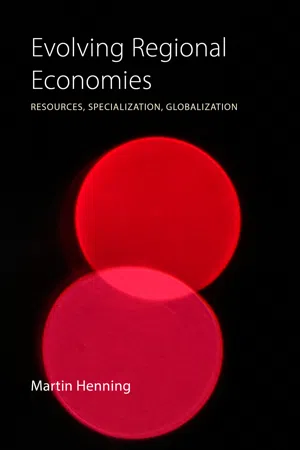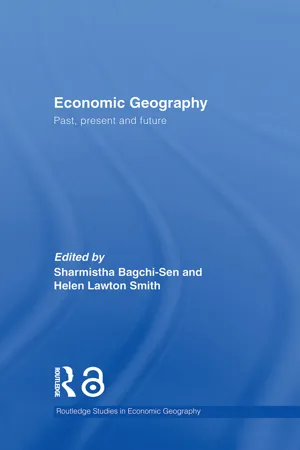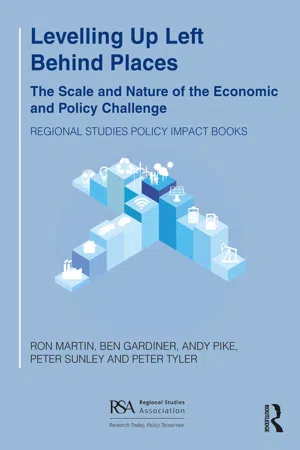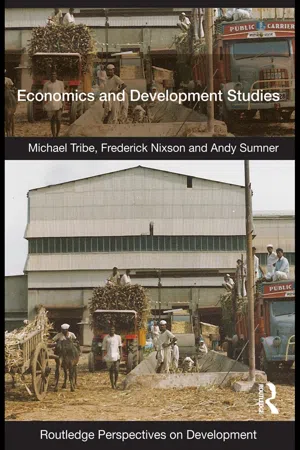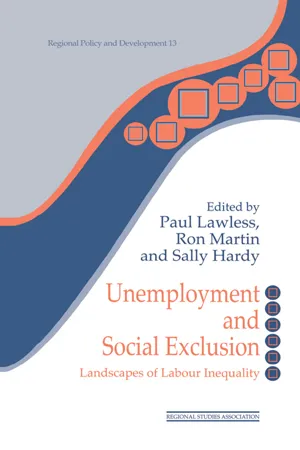Economic Change in the UK
Economic change in the UK refers to the shifts in the country's economic structure, including changes in industries, employment patterns, and trade relationships. These changes have been influenced by factors such as globalization, technological advancements, and government policies. The UK has transitioned from a predominantly industrial economy to one driven by services, finance, and technology, impacting regional development and employment opportunities.
6 Key excerpts on "Economic Change in the UK"
- eBook - ePub
Evolving Regional Economies
Resources, Specialization, Globalization
- Martin Henning(Author)
- 2022(Publication Date)
- Agenda Publishing(Publisher)
...By means of social security systems, better labour market regulations and stricter ethical codes of conduct, firms and governments have addressed some of these concerns in some countries and regions, but much remains to be done for large parts of the globe. Historically, industrial development and improved market economies have certainly led to a general uplift in living standards, but it has not been an unequivocal success. In many parts of the world, people are still struggling hard to provide a minimal living standard for themselves and their families. By learning more about how economic change and long-term regional growth works, we will be able to improve conditions for further economic change so that more people can benefit from economic growth. Today, processes of regional economic change also have to link to how we address the great environmental challenges of our time. It is true that industrialization has drastically improved material and economic well-being for billions of people across the globe. However, it is equally true that this has come at the expense of our natural environment, stretching its resilience to the limit, or even beyond. Future economic change must incorporate a more efficient use of resources and decrease its ecological footprint. It can be debated whether this is achievable within the framework of our current “marketized” organization of the economy. However, the historical failure to organize alternative regimes so far gives little hope for other ways of tackling the issue than a reformed market economy. Lots of insightful books and articles already deal with different aspects of economic growth. In this book, we take a closer look at economic growth and change as geographical processes. This geographical view is important, because processes of growth and change differ considerably across regions, and often within the same country...
- eBook - ePub
Economic Geography
Past, Present and Future
- Sharmistha Bagchi-Sen, Helen Lawton-Smith, Sharmistha Bagchi-Sen, Helen Lawton-Smith(Authors)
- 2006(Publication Date)
- Routledge(Publisher)
...For the greening of industry approach, researches are firm-centred and mainly fall into three categories: consequences of changes in global production networks for economic development, technological innovations and environmental performance, and flows of capital, technology, and information and the dynamic of economic globalization. For the political ecology of industry change approach, researchs are at the beginning of theorizing the process of industrial change, which involves the flow of materials and resources as well as the flow of capital, technology, products and services. The focus is more on the structural foundation and social processes of industrial change. Martin Kenney and Rafiq Dossani examine the potential implications of advanced telecommunications and transportation networks for the reorganization of global workforce. The recent changes in transportation and telecommunication also have an impact on services, especially high-end services like R&D. The impact on high-end services includes the need to redefine services, the relocation of services, and the unrestricted flow of digitized information. These impacts will create new labour processes; economic geographers are ideally positioned to examine the spatial implications of such processes. Henry Yeung writes on the transformation of Asian economies. In the early 1990s, theoretical concepts in economic geography failed to capture the social and institutional contexts influencing the internationalization of firms. Peter Dicken introduced the concept of embeddedness in conceptualizing the dynamic organization of business firms. The concept has been further developed and subsequently resulted in ‘business network perspective’, which is utilized in explaining the economic and non-economic relations at the intra-firm, inter-firm, and extra-firm levels...
- eBook - ePub
Regional Geography (RLE Social & Cultural Geography)
Current Developments and Future Prospects
- Ron Johnston, Joost Hauer, G. Hoekveld(Authors)
- 2014(Publication Date)
- Routledge(Publisher)
...Certainly, not only is the geography of the current transformation remarkably varied and dynamic, but geographical restructuring is a centrally important feature of it. In accounting for the change from organized to disorganized capitalism, Lash Scott Lash and John Urry (1987:84) argue that ‘there is in the spatial an aspect of social relationships’, that there are ‘particular spatial patterns associated with each of these phases of capitalist development’, and, in elucidating ‘what it is like to be “modern”, to live in a modern age’, they stress the ‘extraordinary spatial and temporal transformations … that substantially organize our experience of modern social life’. Not surprisingly, then, the diversity of transition and the fragmentation of previous wholes has led to an increased concern with the geographically distinctive and local and has encouraged a mode of theorizing which stresses fragmentation and unintended consequences. This, I would argue, is extremely dangerous. ‘We still live in a world dominated by capitalism’, and ‘broad social change’ cannot be reduced to the ‘inchoate swirl of human agency’ (Harvey and Scott 1989). Related to this is Neil Smith’s (1987b) critique of realism in which the distinction between necessary and contingent relations leads to the conclusion that, as a product of contingent relations, geography is not accessible to abstract theory. If our objective is to change rather than merely to understand the world, the significance of regional geography lies in reminding us of the ever-present possibilities of making alternative geographies. If the ‘essence of the intellectual enterprise we are engaged in is to construct sustainable generalizations’, regional geography enables us to ‘judge when these generalizations are no longer sustainable’ (Smith 1987b:67)...
- eBook - ePub
Levelling Up Left Behind Places
The Scale and Nature of the Economic and Policy Challenge
- Ron Martin, Ben Gardiner, Andy Pike, Peter Sunley, Peter Tyler(Authors)
- 2021(Publication Date)
- Routledge(Publisher)
...Yet, this interpretation is far too simplistic. While the second form of service sector growth is more dispersed, it is integral to the creative destruction of places seen over past decades, and far from being no longer relevant it continues to shape the economic fortunes of cities, towns and regions. In the case of Britain, we will see that even though it is more spatially dispersed than the agglomerative form of growth, it is nevertheless locationally selective, shaped by consumer spending, and has led to a significant and forceful shift of growth into some smaller cities, towns and rural areas. 3.3 THE CHANGING LOCATION OF EMPLOYMENT To understand these two forms of spatial change, we start by examining key structural changes in the geography of employment. In Britain’s case, it is undoubtedly true that the disappearance of manufacturing jobs through technological change and globalization has undermined the productivity, employment and export bases of many former manufacturing heartlands. 8 The fall in manufacturing employment has been felt most strongly in traditionally industrial regions such as the North East, North West and West Midlands, but also in London; in these areas total production employment has fallen by more than half. 9 There is also a discernible pattern to deindustrialization across settlement types (Figure 3.1). Production employment has fallen most in the major cities and larger towns. There has been a slight increase in production employment since the 2008-10 great recession, but this seems to have been concentrated mainly in London and rural areas...
- eBook - ePub
- Michael Tribe, Frederick Nixson, Andy Sumner(Authors)
- 2010(Publication Date)
- Routledge(Publisher)
...3 Economic growth and structural change 3.1 Introduction All growing economies undergo structural change in terms of the sectoral composition of output and, to a lesser extent, in terms of the sectoral distribution of employment. It would be a strange economy indeed where all economic sectors grew at the same rate leaving the sectoral proportions within the overall economy unchanged. Although the processes of economic growth and structural change are intimately connected, this does not imply that the outcomes of these two processes are necessarily consistent with some normative concept of economic development. Structural change may well destroy existing economic activities and employment opportunities, in both less developed and developed market economies, and development itself becomes a process of creating new economic sectors and activities and developing new employment opportunities. Nevertheless, it is important to discover whether historical patterns of structural change can be identified, and whether or not lessons can be learned from such exercises. 3.2 Why do growing economies undergo structural change? One of the most obvious long-term changes in developing economies is the relative rise of the industrial sector as a whole (which includes construction, utilities – water and sanitation, electricity and gas – and mineral extraction) 1 and of manufacturing in particular. Although the manufacturing sector is usually regarded as being fundamental to the development of a high productivity ‘modern’ economy, the agricultural sector plays a critically important role in economic development – as is explained in Box 3.1 in this chapter. Structural change can be regarded as having a range of dimensions, even in a strictly economic sense. Most of the discussion in this chapter has been restricted to the characteristics of sectors and sub-sectors of the economy...
- eBook - ePub
Unemployment and Social Exclusion
Landscapes of Labour inequality and Social Exclusion
- Sally Hardy, Paul Lawless, Ron Martin(Authors)
- 2013(Publication Date)
- Routledge(Publisher)
...Chapter 4 The Changing Geography of Non-Employment in Britain Anne Green DOI: 10.4324/9781315000251-4 Introduction This chapter provides an evaluative overview of selected key features of continuity and change in the geography of non-employment in Britain in the 1980s, using a range of indicators from various data sources at different spatial scales. The concepts of unemployment, inactivity and nonemployment are reviewed in the first section of the chapter, and the different statistical sources and geographical units referred to subsequently are outlined. In the second section the main emphasis is on outlining selected features of changing geographical patterns of non-employment, rather than attempting to ‘explain’ them in a comprehensive fashion. Amongst the changes reviewed are the convergence of regional unemployment rates in the late 1980s and early 1990s, and geographical variations in timing of entry into recession in 1979 and 1989/90. Substantial intra-regional variations in unemployment are highlighted, and the tendency for an increasing proportion of variation in local unemployment rates to be accounted for by intra-regional, rather than inter-regional, differences is reviewed. The disproportionate relative increase in unemployment in the country’s large urban areas is identified as a major feature of change in the 1980s, with non-employment becoming increasingly extensive in many urban labour markets. A discussion of the concept of segregation follows in the third section of the chapter. A range of measures of different aspects of segregation are operationalised using data from the Census of Population, and the main features of geographical patterns of segregation of non-employed sub-groups are outlined. In particular, the increasing segregation of the non-employed in the largest cities is highlighted...
